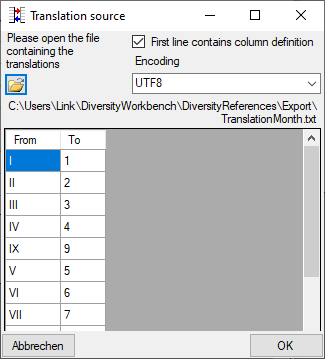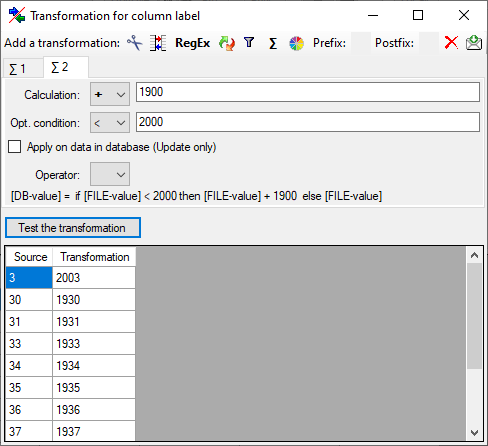

The data imported may be transformed e.g. to adapt them
to a format demanded by the database. Click on the
 button to open a window as shown below.
button to open a window as shown below.

Here you can enter 4 types of transformation that should
be applied to your data.
 Cut out parts,
Cut out parts,
 Translate contents from the file,
RegEx apply regular expressions or
Translate contents from the file,
RegEx apply regular expressions or
 Replace text in the data from the file. All transformations will be applied in the
sequence they had been entered. Finally, if a prefix and/or a postfix are defined,
these will be added after the transformation. To remove a transformation, select
it and click on the
Replace text in the data from the file. All transformations will be applied in the
sequence they had been entered. Finally, if a prefix and/or a postfix are defined,
these will be added after the transformation. To remove a transformation, select
it and click on the
 button.
button.

With the
 cut transformation you can restrict the data taken from the file to a part of the
text in the file. This is done by splitters and the position after splitting. In
the example below, the month of a date should be extracted from the information.
To achieve this, the splitter '.' is added and than the position set to
2. You can change the direction of the sequence with the button
cut transformation you can restrict the data taken from the file to a part of the
text in the file. This is done by splitters and the position after splitting. In
the example below, the month of a date should be extracted from the information.
To achieve this, the splitter '.' is added and than the position set to
2. You can change the direction of the sequence with the button
 Seq starting at the first position and
Seq starting at the first position and
 starting at the last position. Click on the button Test the transformation
to see the result of your transformation.
starting at the last position. Click on the button Test the transformation
to see the result of your transformation.


The
 translate transformation translates values from the file into values entered by
the user. In the example above, the values of the month cut out from the date string
should be translated from roman into numeric notation. To do this click on the
translate transformation translates values from the file into values entered by
the user. In the example above, the values of the month cut out from the date string
should be translated from roman into numeric notation. To do this click on the
 button to add a translation transformation (see below). To list all different values
present in the data, click on the
button to add a translation transformation (see below). To list all different values
present in the data, click on the
 button. A list as shown below will be created. You may as well use the
button. A list as shown below will be created. You may as well use the
 and
and
 buttons to add or remove values from the list or the
buttons to add or remove values from the list or the
 button to clear the list. Than enter the translations as shown below. Use the
button to clear the list. Than enter the translations as shown below. Use the
 save button to save entries and the Test the transformation button to see
the result.
save button to save entries and the Test the transformation button to see
the result.

To load a predefined list for the transformation use the
 button. A window as shown below will open. Choose the encoding of the data in you
translation source, if the first line contains the column definition and click on
the button to open a file. Click OK to use the values from the file for the
translation.
button. A window as shown below will open. Choose the encoding of the data in you
translation source, if the first line contains the column definition and click on
the button to open a file. Click OK to use the values from the file for the
translation.

To load a database table for the transformation use the
 button (see main
translation window above). A window as shown below will
open, where you may select a database table for the translation. Choose the table and the columns for the translation. Click OK to use the values from the
table for the translation. Only unique values from the table will be
used to ensure an unequivocal translation.
button (see main
translation window above). A window as shown below will
open, where you may select a database table for the translation. Choose the table and the columns for the translation. Click OK to use the values from the
table for the translation. Only unique values from the table will be
used to ensure an unequivocal translation.

The values of the database table will be listed underneath as shown
below. For the translation will only be regarded if the manual list does
not contain the corresponding table. That means that content in the
manual table will overwrite corresponding content in the database table.
To remove the database table use the
 button.
button.

The transformation using regular expressions will transform the values according to the entered Regular expression and Replace by vales. For more details please see documentations about regular expressions.


The replacement transformation replaces any text in the data by a text specified by the user. In the example shown below, the text "." is replaced by "-".


The calculation transformation performs a calculation on numeric value, dependent on an optional condition. In the example below, 2 calculations were applied to convert 2-digit values into 4 digit years.


The filter transformation compares the values from the
file with a value entered by the user. As a result you can either
 Import content of column in file or
Import content of column in file or
 Import a fixed value. To select another column that should be compared, click
on the
Import a fixed value. To select another column that should be compared, click
on the
 button and choose a column from the file in the window that will open. If the column
that should be compared is not the column of the transformation, the number of the
column will be shown instead of the
button and choose a column from the file in the window that will open. If the column
that should be compared is not the column of the transformation, the number of the
column will be shown instead of the
 symbol. To add further filter conditions use the
symbol. To add further filter conditions use the
 button. For the combination of the conditions you can choose among AND and OR.
button. For the combination of the conditions you can choose among AND and OR.


The color transformation offers the transformation of color values between the three formats HEX values (#rrggbb), decimal value triples (rrr, ggg, bbb) and (negative) integer numbers.
